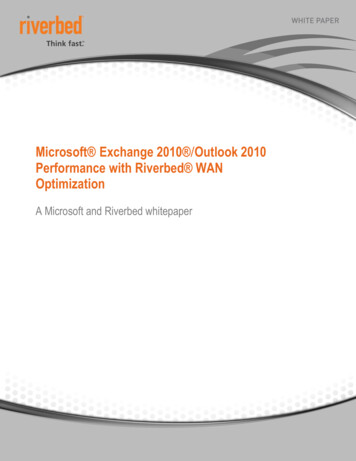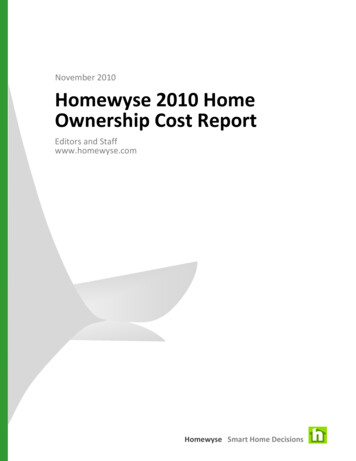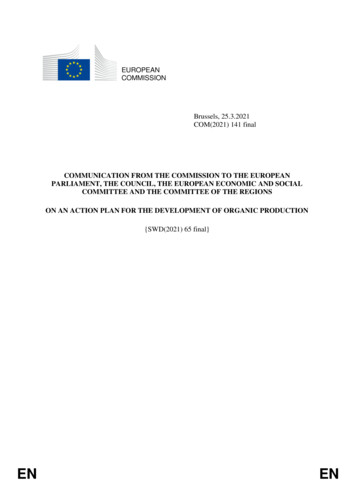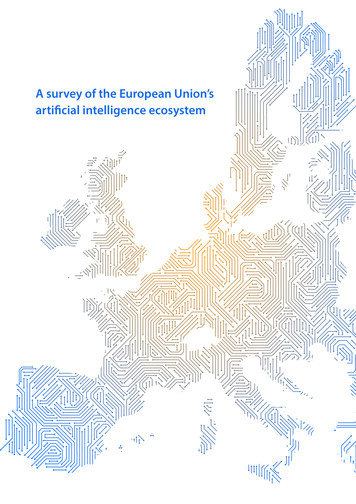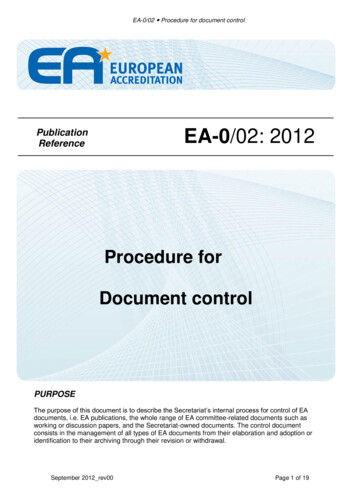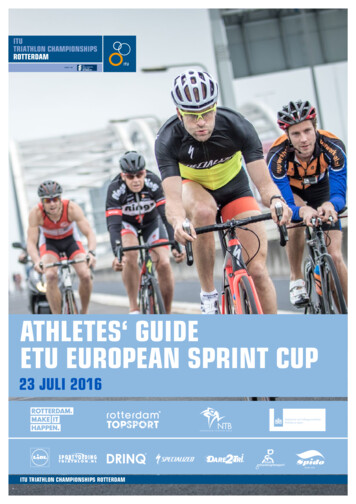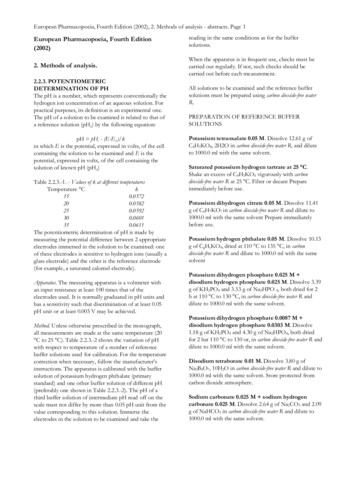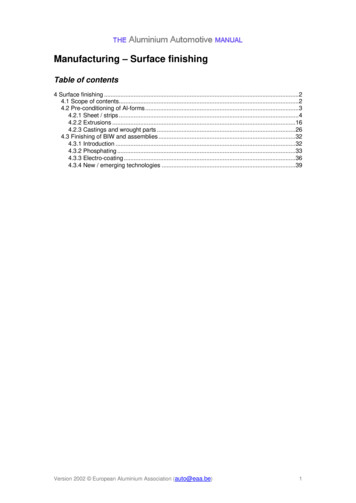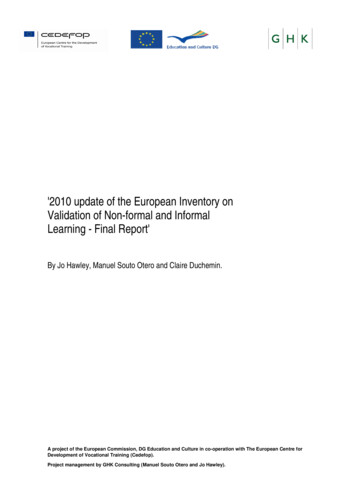
Transcription
'2010 update of the European Inventory onValidation of Non-formal and InformalLearning - Final Report'By Jo Hawley, Manuel Souto Otero and Claire Duchemin.A project of the European Commission, DG Education and Culture in co-operation with The European Centre forDevelopment of Vocational Training (Cedefop).Project management by GHK Consulting (Manuel Souto Otero and Jo Hawley).
Update to the European Inventory on Validation of Non-formal and informal learningFinal ReportCONTENTS1 INTRODUCTION . 12 VALIDATION OF NON-FORMAL AND INFORMAL LEARNING – AEUROPEAN PERSPECTIVE. 32.1 European Context. 32.2 Cross-country analysis . 52.3 Level of development. 52.4 Types of approach or system . 122.4.1 Countries with a centrally regulated approach . 132.4.2 Countries with local, project-based or sectoral initiatives. 152.5 Factors influencing the level of development or approach to validation. 172.5.1 Initiatives driven by a wider policy framework or context, including theeconomic context . 172.5.2 Economic drivers . 192.5.3 Stakeholders / institutional framework . 192.5.4 Impact of parallel developments in education and training policy . 232.5.5 Impact of European-level drivers . 272.6 Overview of benefits / outcomes/ impact . 282.7 Challenges for the future . 292.7.1 Terminology and aims . 29In order to ensure that collaborative, transnational actions can reach their desiredgoals, partners often seem to ‘agree to disagree’ on the question of terminology but itdoes remain a potential challenge to wider implementation and take-up, particularlyin terms of public awareness and understanding of the concept of validation. Ittherefore seems particularly important that individual validation initiatives make cleartheir aims and scope to potential users and stakeholders and that greater efforts aremade to adopt a common terminology in this area. 302.7.2 Sustainability and financing issues . 302.7.3 The need for a cultural shift / greater trust in validation . 312.7.4 From policy to practice, and from pilot and ad hoc projects to the mainstream322.7.5 Data collection and a more robust evidence base . 332.7.6 Variation in provision . 343 CONCLUSION. 364 REFERENCES . 37ANNEX 1 – TECHNICAL UPDATE . 39ANNEX 2 – COUNTRY OVERVIEW BY LEVEL OF DEVELOPMENT . 40
Update to the European Inventory on Validation of Non-formal and informal learningFinal ReportANNEX 3 – RESULTS OF SURVEY OF PRACTITIONERS . 41ANNEX 4 – CATALOGUE OF PROJECTS. 42ANNEX 5 – GUIDANCE NOTE FOR COUNTRY EXPERTS. 43ANNEX 6 – SURVEY OF PRACTITIONERS / PROJECTS. 44
Update to the European Inventory on Validation of Non-formal and informal learningFinal Report1INTRODUCTIONThis final report is the last deliverable of the 2010 Update to the European Inventory onValidation of Non-formal and Informal Learning (Reference No. 2009-5035 /001-001).The European Inventory provides a unique record on how validation is already being usedat national, regional and local level to address issues relating to lifelong learning,employment and social exclusion. This is particularly important in the context of the currenteconomic crisis, which has accelerated the importance of validation drivers identified in the2007 Inventory, such as the need for effective re-deployment of the adult population intoemployment. A number of countries have recognised the role validation has to play inaddressing skills shortages and in supporting those facing redundancy to identify andpursue an alternative career pathway. Other initiatives recognise the role of validation incombating social exclusion, by empowering ‘the low qualified’ and other disadvantagedgroups to identify and understand their own competences and potential.A new ‘landscape’ in the validation of non-formal and informal learning has appeared sincethe last Inventory was produced. This is now a fast-moving field, with developments takingplace at a number of levels and in a number of sectors in each country (although it shouldbe acknowledged that there are a small number of countries where little progress has beenobserved since the last Inventory update). With the increasing importance of validation notonly as a topic for discussion but as a field of activity, the process of updating the EuropeanInventory has become a more important and increasingly challenging task, with eachcountry update having to take account of developments across the sectors of, for example,general, vocational, adult and higher education and training, as well as the private and thirdsectors and projects supported by European and national funding sources.This report is intended to complete the portfolio of products which make up the 2010European Inventory by providing a ‘European perspective’ to the Update, which has beenstructured to link with the European Guidelines on Validation, as follows: European Perspective: final report; thematic reports; case studies on EU-fundedinitiatives; National Perspective: country updates; case studies; thematic reports; final report; Organisational Perspective: country updates; case studies; thematic reports; Individual Perspective: country updates; case studies; thematic reports; Quality Assurance: country updates; case studies; Assessment methods: country updates; case studies; thematic report on assessmentmethods; Role of validation practitioners: country updates; case studies.1The report is accompanied by 34 country reports, 10 case studies and four thematicreports, which have also been prepared with the Guidelines in mind, as outlined above.In order to fulfil the requirement of providing a ‘European perspective’ on validation, thisreport focuses on providing a synthesis of the information presented in the various otherproject outputs. Each country update has been reviewed, together with the case studies1There are two reports for Belgium and the UK, in order to take account of the devolved responsibility foreducation and training policy in these countries1
Update to the European Inventory on Validation of Non-formal and informal learningFinal Reportand thematic reports, in order to provide an overview of progress and trends across the 32countries covered by the study and to highlight some key issues and challenges.A technical update is provided in Annex 1 to confirm the methodology pursued in order todeliver the project. In this technical update, suggestions are also made as to how theInventory might be taken forward in the future to continue to serve as a useful referencepoint for its readers.The following additional documentation can be found in the annexes to the report.Annex 1:Technical updateAnnex 2:Cross-country overview by level of developmentAnnex 3:Results of survey of practitionersAnnex 4:Catalogue of projectsAnnex 5:Guidance note for country expertsAnnex 6:Survey of practitioners/ projects2
Update to the European Inventory on Validation of Non-formal and informal learningFinal Report2VALIDATION OF NON-FORMAL AND INFORMAL LEARNING – AEUROPEAN PERSPECTIVE2.1European ContextValidation of non-formal and informal learning (the process of its identification,documentation and recognition) is recognised as an important tool in the pursuit ofeconomic and social goals at European level. A number of key developments, eitherdirectly relating to validation, or contributing to or promoting further development ofvalidation, have started or gathered further momentum between the previous and thecurrent version of the Inventory, including: The European Principles for the Identification and Validation of non-formal andinformal learning, which were intended to encourage and guide the development ofcomparable approaches and systems, by providing Member States with some keyprinciples for the implementation of validation; The work of the cluster on Recognition of Learning Outcomes, which opened updiscussions on key issues relating to validation, including for example costs andbenefits and quality assurance; The 2009 European Guidelines on Validation, which provide guidance for policymakers and practitioners on how to address the main challenges associated with thedevelopment of validation approaches and systems; The European Qualifications Framework, which has encouraged Member States towork towards the introduction of their own National Qualifications Frameworks,defining levels of learning in terms of learning outcomes; The Action Plan on Adult Learning, which identified several activities in the area ofvalidation to be delivered by the Commission in the period 2008-2010.; The European Credit System for VET (ECVET), a unit-based credit system forvocational education and training, which requires a validation system in order torecognise learning acquired through non-formal and informal means; The European Quality Assurance Reference Framework for VET, which provides aframework for a common approach to QA in VET and as such also concernsvalidation; Europass, a set of documents which are recognised across Europe, which peoplecan use to present their skills and qualifications and which enable individuals to‘visualise and validate’ their learning outcomes; The Youthpass tool for young people (see the 2010 Inventory case study on this toolfor further information), which enables young people to ‘visualise and validate’learning outcomes gained through Youth in Action projects; The proposal for a European Skills, Competences and Occupations (ESCO)taxonomy, a multilingual dictionary linking skills and competences to occupations, willhelp to create a common language for employment and education / training andcould help to raise the profile of validation; and The Bologna Process in higher education and the European Universities’ Charter onLifelong Learning, which includes ‘recognition of prior learning’ as one of the ten3
Update to the European Inventory on Validation of Non-formal and informal learningFinal Reportcommitments made by universities in addressingimplementation of lifelong learning strategies.thedevelopmentandMoreover, the long-term commitment to validation has been recently reinforced. Therevised Strategic Framework for Cooperation in Education and Training until 2020 (adoptedin 2009) identified ‘making lifelong learning a reality’ as one of its four strategic objectives tobe addressed in the upcoming decade. Within this objective, the Strategy states that “workis needed to ensure the development of national qualifications frameworks based onrelevant learning outcomes and their link to the European Qualifications Framework, theestablishment of more flexible learning pathways – including better transitions between thevarious education and training sectors, greater openness towards non-formal and informallearning, and increased transparency and recognition of learning outcomes”. Thus, theStrategy makes clear that there is more work to be done in order to increase theimplementation of validation in the Member States.2The Europe 2020 Strategy , the EU’s growth strategy for the coming decade,acknowledges the role of validation in supporting young people, particularly those withfewer opportunities and / or at risk of social exclusion, to access the labour market. TheCommission sets out a commitment under its ‘Youth on the Move’ flagship initiative topromote the recognition of non-formal and informal learning. Validation is also referred tounder Employment Guideline 9 3 , which refers to the need to take account of non-formaland informal learning in actions to improve the quality and performance of education andtraining systems.Yet there is still much more to be done to meet the objectives set out in these strategicdocuments. While in a small number of countries, validation is now being used to supportlarge numbers of learners, in many it remains a marginal activity, with pockets of activityand/ or good practice. While systems begin to be in place in general terms, issuespertaining to their effective use become more relevant in the policy agenda.In late 2010, the Commission launched a public consultation on possible future action tosupport the promotion and validation of non-formal and informal learning 4 . The aim is tocollect views on whether further action is needed, what type of action is required and whichpolicy priorities should be given attention. Once the consultation period has closed, theEuropean Commission services will prepare a report on its results, which will be publishedon the website of the Directorate General for Education and Culture in the first semester of2011. This report will give an indication of how the Commission will take the responses intoaccount in preparing its proposal for future action on the promotion and validation of nonformal and informal learning. Current proposals for further action include the introduction ofan integrated Europass Skills Passport, capable of recording the full range of formal, nonformal and informal learning whether acquired abroad or domestically, and a proposal for adraft Council Recommendation on the promotion and validation of non-formal and informallearning in 2011, under the auspices of the Europe 2020 Flagship Initiative ‘Youth on the5Move’ .2Europe 2020 Strategy. Internet: http://ec.europa.eu/europe2020/index en.htm3Europe 2020 Integrated Guidelines for the Economic and Employment Policies of the Member States. gs/education culture/consult/learning en.html5European Commission, Youth on the Move, Luxembourg: Publications Office of the European Union. Internet:http://ec.europa.eu/education/yom/com en.pdf4
Update to the European Inventory on Validation of Non-formal and informal learningFinal Report2.2Cross-country analysisFor the 2010 Update, the scope of the country updates has widened significantly, toincorporate all aspects of validation as outlined in the European Guidelines. The aim is tolook at validation not only from a national perspective but also from an organisational andindividual perspective. Key issues such as quality assurance and practitioner profiles arealso covered in the country updates.Based on a review of the country updates, it seems that while in most countries there isnow recognition of the role validation has to play and a commitment to introducing,implementing, or consolidating systems of validation, the actual scale of implementation ‘onthe ground’ – i.e. the number of people who have benefited from validation and / or thenumber of qualifications awarded - remains on the whole relatively small in scale, with theexception of a small number of countries and initiatives. It is not that systems are not used.Rather, it is that their full potential has clearly not been reached. There may be a number ofreasons for this. For example, in some countries there may be structural barriers when aproject needs to be expanded to a national level or be embedded in the apparatus of theeducation system. The commitment to validation in policy documents may not be supportedby adequate funding to enable providers to carry it out in practice. Or the formal educationsystem may already be considered to be flexible enough to reduce the pressure forvalidation.This section commences with a cross-country analysis of the 2010 country updates, toassess how countries can be categorised according to their ‘level of development’. Thefollowing section provides a second categorisation of the countries, according to theapproach taken to developing or implementing a system of validation.2.3Level of developmentIn the previous European Inventory update, countries were categorised according to theirlevel of development, as being either at a high, medium or low level. This categorisation by‘level of development’ is useful to obtain a view of the state of the art (and by comparisonwith the 2007 Inventory relative progress made by different countries) in validation.However, it is important to note that the categorisation provides only an overall assessment.In fact, the situation is often complex and multi-faceted at the national level, as differentdegrees of progress and development are in operation in different sectors (e.g. vocationaleducation/ training, higher education, the private sector, etc.) within the same country.Furthermore, while there may on the surface appear to be a comprehensive system inplace, in practice it may not be implemented to its full potential by providers, or take-up maybe low by actual learners, for various reasons (e.g. lack of awareness). In contrast, somecountries may not have a clear national legal or policy framework but have bottom-upinitiatives with very high levels of take-up. The effectiveness of the systems in place andtheir impact on individuals may also differ. For such reasons, it is particularly difficult tocategorise the 32 countries concerned in a ‘neat’ fashion. Nevertheless, an attempt will bemade here.In order to take account of the great diversity in the level of development of the 32 countriescovered by the Inventory, it is necessary to extend the three categories employed in theprevious versions (high, medium and low degree of development), to four categories: high,medium-high, medium-low and low. The focus of this classification is on relative, rather thanabsolute, levels of performance. This is justified because relative comparisons areconsidered to be more useful at the time of benchmarking in this area than stricter‘absolute’ levels of performance against a set cannon.5
Update to the European Inventory on Validation of Non-formal and informal learningFinal ReportAn indicative spread of countries is suggested in the table below, based on the informationprovided within the country updates. As is clear from the information provided below, this isnot an ‘exact science’ and this table is based on a judgement by the authors of this report.Nevertheless, it serves to give an idea of the extent of development across ay,Medium-highMedium-lowLowDenmark, hern Ireland), onia),CzechRepublic,Estonia,Iceland, Italy, Bulgaria,Croatia,Cyprus,Greece,Hungary, Latvia, Malta,Poland, Turkey Countries with a high degree of developmentIn 2007 this category was defined as countries which have “moved from theintroduction of validation policies to the implementation of validation practices”. Givendevelopments in this area, it is now more appropriate to include in this categorycountries which have established practices for validation, encompassing all or mostsectors of learning, and which already show a significant level of take-up. In thiscategory, countries generally have a national legislative framework or national policy inplace, which might be one national policy relating to validation in all sectors, or a set ofpolicies / laws relating to different sectors which together form an overall framework.Countries which would fall under this category include France, Norway and Portugal.FranceValidation of prior learning has been established as a right for everycitizen in France. The current system (Validation des Acquis del'Expérience, VAE), which was established in 2002, is used to deliverwhole or partial qualifications. Each body awarding qualifications hasdeveloped its own rules for the context-specific implementation of theprinciples outlined in the legislation.The VAE system stems from legislation introduced in 1992 forqualifications awarded by the Ministries of Education and Agriculture,extended to qualifications delivered by the Ministry of Youth and Sportin 1999, and to all main types of qualification in 2002. The most recentchange in 2009 aimed to increase the number of individuals accessingthe VAE process, in particular private sector workers, and to developguidance for VAE.Since 2002 a significant investment has been made in the highereducation sector in particular to produce standards (référentiels)described in terms of learning outcomes in order to facilitate VAE (allvocational training diplomas included in the national qualificationsdirectory (RNCP) must be described in terms of learning outcomes). Inaddition, in higher education, recognition of professional experiencehas also been used for a long time (in fact it dates back to the 1930s)to allow access to individuals who do not meet formal requirementcriteria and, in some cases, acquisition of a diploma.6
Update to the European Inventory on Validation of Non-formal and informal learningFinal ReportThe number of VAE candidates per year is high in comparison to mostother European countries, with 53,000 in 2008. The number ofqualifications awarded through VAE in this year was between 72,000and 75,000.NorwayNon-formal and informal learning has deep historic roots in Norway andhas been developed in parallel with the formal education system. It ishighly recognised in civil society and is important for skill formation inthe Norwegian economy.There is a comprehensive legal framework in place covering thedifferent sectors of learning (i.e. vocational education, adult education,Higher Education). There is also quantitative data to show relativelyhigh levels of take-up:- Admissions to a study programme in higher education, based ondocumented prior learning by adults lacking formal qualifications iswidespread. The number of HE applicants who requested that theirnon-formal and informal qualifications be taken into account in theirapplication to enter HE was 2,565 in 2008.- In terms of the crafts examination based on practical workexperience, the latest available data show that on average, around6,000 individuals take this examination each year and that around 95%of these are successful.- Around a third (3,162) of the total number (9,439) of adults whoapplied for enrolment in upper secondary education and training in2008 had undergone validation of non-formal and informal learning.While validation in Norway is based on a national approach, withnational laws and common principles, there is a certain degree ofinstitutional autonomy, particularly at higher education level.PortugalIn Portugal, the national system of validation is one part of the strategyto reduce the qualifications deficit among the adult population, notablythrough the New Opportunities initiative launched in December 2005.In 2001 the National System for the Recognition, Validation andCertification of Competences (SNRVCC) was created. TheRecognition, Validation and Certification of Competences (RVCC) nowrepresents an important part of the measures in place to meet thegoals of the New Opportunities initiative. New Opportunities defines astrategy for national education and training in Portugal, aiming to raiseththe qualifications level of the population to secondary level (12 grade).In higher education, recent legislation allows access to adult studentswho do not meet the standard admissions requirements based on therecognition of prior learning.According to data from the National Agency for Qualifications (ANQ),by April 2010, 324,370 adults had been granted a certificate throughRVCC processes (i.e. as a result of validation processes andcomplementary learning).7
Update to the European Inventory on Validation of Non-formal and informal learningFinal Report Countries with a medium-high degree of developmentThis category would include either countries where there is a national system, or aframework of systems, for validation but take-up remains relatively low, or countrieswhere there is a particularly well-established system of validation in a certain sectorwith a high level of take-up, but not a national framework in place.Examples of countries which fall under this category include Denmark, Germany andSpain.DenmarkThe validation of non-formal and informal learning has been high onthe policy agenda in Denmark for more than a decade and is welldeveloped especially in VET, adult education programmes and tertiaryeducation. The recent key legislation on validation of prior learning isAct no 556 of the 6 June 2007 on the development of the recognition ofprior learning in adult education and continuing training. It coverssingle course subjects in general adult education and general uppersecondary education, vocational training programmes; basic adulteducation; short-cycle and medium-cycle post-secondary adulteducation (Diploma programmes).Validation of non-formal and informal learning aimed at all citizens,often with a special focus on low-qualified people, also featuresstrongly in policies and strategies focusing more broadly on lifelonglearning. Although recognition of prior learning has been establishedfor some time it is also considered that more needs to be done torecognise competences achieved at work and from taking part in nonformal adult education and training etc.The Danish Ministry of Education has launched a number of initiativesthat seek to improve the understanding of prior learning assessmentand to promote its use (e.g. setting up a National Knowledge Centre forValidation of Prior Learning) and is evaluating the implementation ofthe legislation in 2011-2011 with the view to defining a new action planto promote the validation of prior learning.Validation activity is still relatively low because the new regulations arestill under implementation. But at the same time the development ofactivity is increasing within all fields of education.GermanyIn Germany, there is currently no legal framework and no standardisedsystem for the validation of non-formal and informal learning at nationallevel. Due to the complex allocation of responsibilities in Germany inthe field of education and training, there is a variety of approaches,particularly below political level. Similarly there is no standardisedfunding framework for validation.In vocational education and training, the External students’ examinationunder § 45 (2) of the Vocational Training Act (BBiG) includes provisionfor the validation of prior learning leading to the award of a qualificationin a recognised apprenticeship trade.Access to higher education for qualified workers has been regulatedsince 2009 by a decision of the Standing Conference of the Ministers ofEducation and Cultural Affairs of the German Länder.There is also a well-known system of formative validation for bothadults and young people, entitled ProfilPASS. This initiative is moreformative in its approach and emphasises the identification and8
Update to the European Inventory on Validation of Non-formal and informal learningFinal Reportdocumentation of learning outcomes, rather than their recognition forqualifications purposes. Since 2006 the ProfilPASS has been used bymore than 80,000 people, of which half were adults (43,000) and theother half young people (41,600). There are now more than 4,000ProfilPASS Counsellors (‘Beratende’), about 70 ‘Multiplikatoren’(‘opinion formers’) and more than 50 ‘Dialogzentren’ (‘Dialoguecentres’).In addition, many different approaches to recognition and validation ofprior learning supported by public funds have been developed atregional and national level for different target groups in recent years.SpainToday there are some opportunities for validation in relation to HigherEducation (HE) and now also professional competences (up to acertain level). Some Autonomous Communities (ComunidadesAutónomas – CCAAs) have also established procedures for validation.In Higher Education (HE), since the 1970s individuals aged over 25without upper secondary education have been entitled to access HEupon satisfactory performance in ‘over-25s’ HE access exams –although without receiving a secondary school qualification through thisprocess. Later, from the early 2000s new measures were put in placeat national level in order to further recognise competences acquiredthrough non-formal and informal learning. A new decree to regulatevalidation procedures in Higher Education has been drafted and will befinalised by the end of 2010.In 2009, the Royal Decree on the recognition of professi
Learning - Final Report' By Jo Hawley, Manuel Souto Otero and Claire Duchemin. . ANNEX 1 – TECHNICAL UPDATE.39 ANNEX 2 – COUNTRY OVERVIEW BY LEVEL OF DEVELOPMENT.40. Update to the European Inventory on Validation


